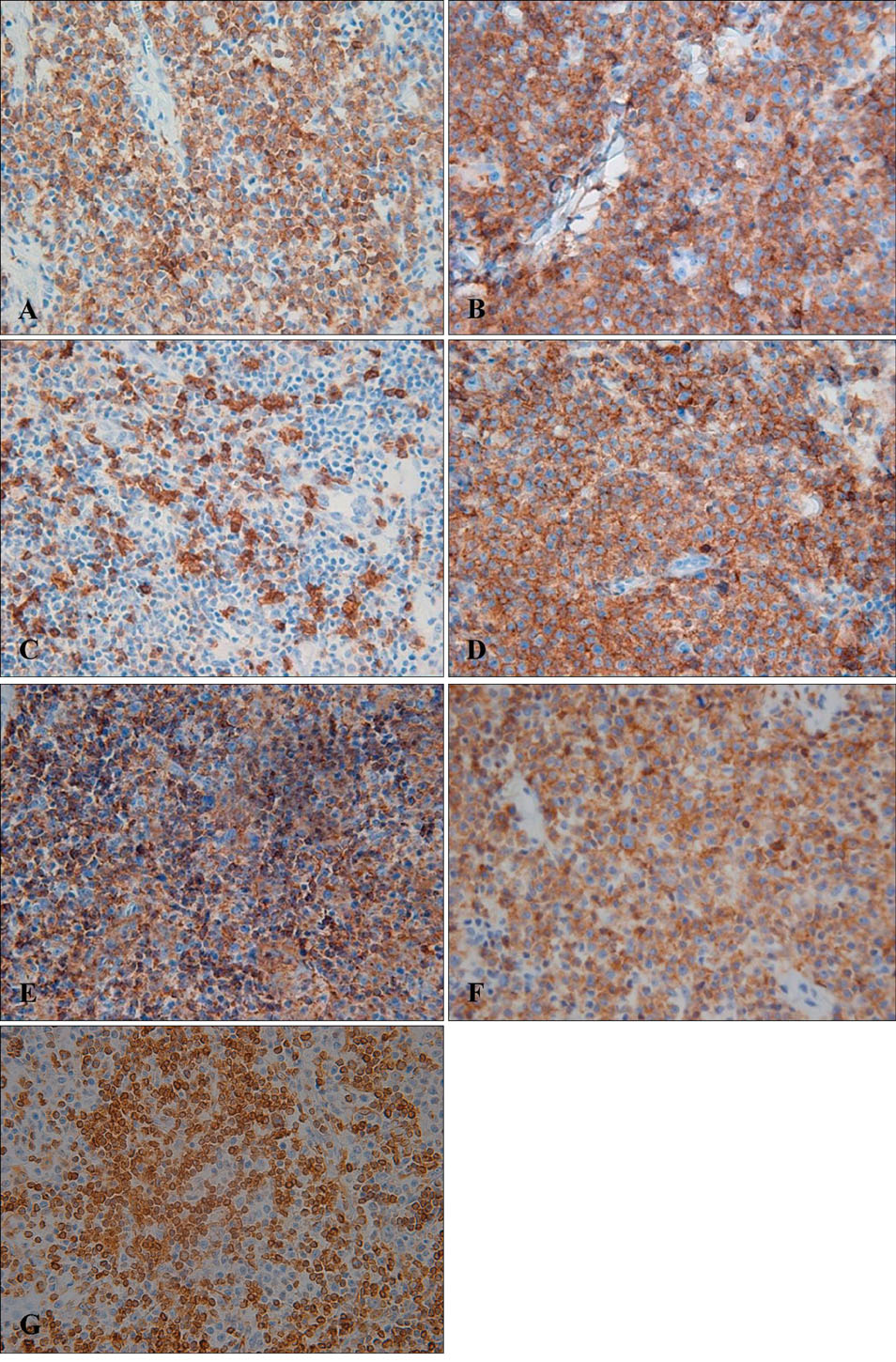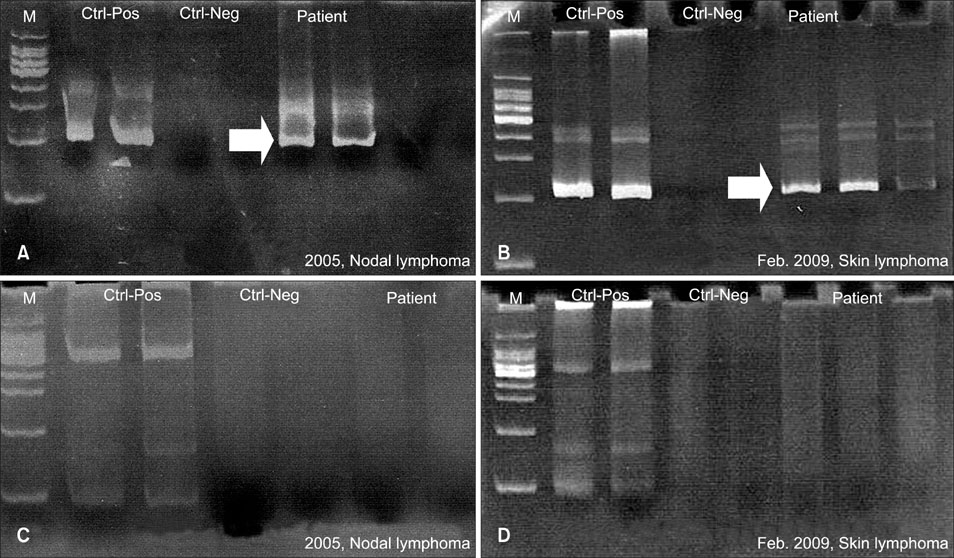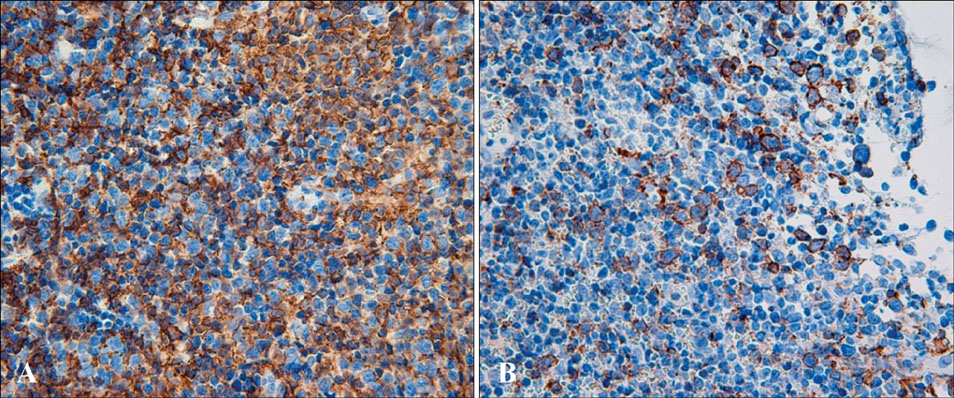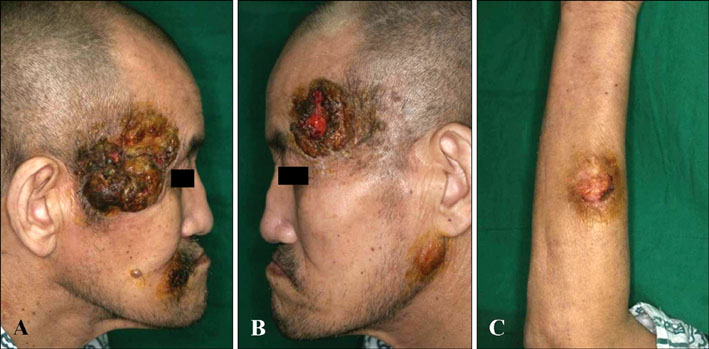Ann Dermatol.
2011 Nov;23(4):529-535.
CD20 Positive T Cell Lymphoma Involvement of Skin
- Affiliations
-
- 1Department of Dermatology, College of Medicine, Dong-A University, Busan, Korea. khkim@dau.ac.kr
Abstract
- CD20 positive T cell lymphoma is a rare condition that is associated with the coexpressions of CD20 and T cell markers, such as, CD3, CD5, or UCHL-1. Positivity for CD20 in this tumor represents an aberrant immunophenotype, but the presence of monoclonal T cell receptor (TCR) gene rearrangements and negativity for immunoglobulin heavy chain gene rearrangement indicate that this tumor is a T cell lymphoma. The majority of cases of CD20 positive T cell lymphoma have been reported as immature peripheral T cell lymphoma not otherwise specified. However, we believe that this disease is likely to be re-listed as a new disease entity after its pathogenesis has been elucidated and more cases have been evaluated. Here, we present a case of peripheral T cell lymphoma coexpressing CD20 and T cell markers with a demonstrable TCR gene rearrangement, in a patient who had been misdiagnosed as having B cell type lymphoma 4 years previously. We hypothesize that in this case initially circulating normal CD20+ T cell subsets underwent neoplastic transformation and CD20 positive T cell lymphoma subsequently developed in the lymph node, and then recurred in the skin due to systemic disease or metastasized from the nodal disease.
MeSH Terms
Figure
Reference
-
1. Mohrmann RL, Arber DA. CD20-Positive peripheral T-cell lymphoma: report of a case after nodular sclerosis Hodgkin's disease and review of the literature. Mod Pathol. 2000. 13:1244–1252.
Article2. Balmer NN, Hughey L, Busam KJ, Reddy V, Andea AA. Primary cutaneous peripheral T-cell lymphoma with aberrant coexpression of CD20: case report and review of the literature. Am J Dermatopathol. 2009. 31:187–192.
Article3. Sen F, Kang S, Cangiarella J, Kamino H, Hymes K. CD20 positive mycosis fungoides: a case report. J Cutan Pathol. 2008. 35:398–403.
Article4. Magro CM, Seilstad KH, Porcu P, Morrison CD. Primary CD20+CD10+CD8+ T-cell lymphoma of the skin with IgH and TCR beta gene rearrangement. Am J Clin Pathol. 2006. 126:14–22.
Article5. Yokose N, Ogata K, Sugisaki Y, Mori S, Yamada T, An E, et al. CD20-positive T cell leukemia/lymphoma: case report and review of the literature. Ann Hematol. 2001. 80:372–375.
Article6. Quintanilla-Martinez L, Preffer F, Rubin D, Ferry JA, Harris NL. CD20+ T-cell lymphoma. Neoplastic transformation of a normal T-cell subset. Am J Clin Pathol. 1994. 102:483–489.
Article7. Warzynski MJ, Graham DM, Axtell RA, Zakem MH, Rotman RK. Low level CD20 expression on T cell malignancies. Cytometry. 1994. 18:88–92.
Article8. Buckner CL, Christiansen LR, Bourgeois D, Lazarchick JJ, Lazarchick J. CD20 positive T-cell lymphoma/leukemia: a rare entity with potential diagnostic pitfalls. Ann Clin Lab Sci. 2007. 37:263–267.9. Sun T, Akalin A, Rodacker M, Braun T. CD20 positive T cell lymphoma: is it a real entity? J Clin Pathol. 2004. 57:442–444.
Article10. Yao X, Teruya-Feldstein J, Raffeld M, Sorbara L, Jaffe ES. Peripheral T-cell lymphoma with aberrant expression of CD79a and CD20: a diagnostic pitfall. Mod Pathol. 2001. 14:105–110.
Article11. Rahemtullah A, Longtine JA, Harris NL, Dorn M, Zembowicz A, Quintanilla-Fend L, et al. CD20+ T-cell lymphoma: clinicopathologic analysis of 9 cases and a review of the literature. Am J Surg Pathol. 2008. 32:1593–1607.12. Balmer NN, Hughey L, Busam KJ, Reddy V, Andea AA. Primary cutaneous peripheral T-cell lymphoma with aberrant coexpression of CD20: case report and review of the literature. Am J Dermatopathol. 2009. 31:187–192.
Article13. Oshima H, Matsuzaki Y, Takeuchi S, Nakano H, Sawamura D. CD20+ primary cutaneous T-cell lymphoma presenting as a solitary extensive plaque. Br J Dermatol. 2009. 160:894–896.
Article14. Gill HS, Lau WH, Chan AC, Leung RY, Khong PL, Leung AY, et al. CD20 expression in natural killer T cell lymphoma. Histopathology. 2010. 57:157–159.
Article15. Xiao WB, Wang ZM, Wang LJ. CD20-positive T-cell lymphoma with indolent clinical behaviour. J Int Med Res. 2010. 38:1170–1174.
Article16. Tarkowski M. Expression and a role of CD30 in regulation of T-cell activity. Curr Opin Hematol. 2003. 10:267–271.
Article17. Murayama Y, Mukai R, Sata T, Matsunaga S, Noguchi A, Yoshikawa Y. Transient expression of CD20 antigen (pan B cell marker) in activated lymph node T cells. Microbiol Immunol. 1996. 40:467–471.
Article18. Venizelos ID, Tatsiou ZA, Mandala E. Primary cutaneous T-cell-rich B-cell lymphoma: a case report and literature review. Acta Dermatovenerol Alp Panonica Adriat. 2008. 17:177–181.19. Medeiros LJ, Elenitoba-Johnson KS. Anaplastic large cell lymphoma. Am J Clin Pathol. 2007. 127:707–722.
Article20. Cerny T, Borisch B, Introna M, Johnson P, Rose AL. Mechanism of action of rituximab. Anticancer Drugs. 2002. 13:Suppl 2. S3–S10.
Article21. Hamilton-Dutoit SJ, Pallesen G. B cell associated monoclonal antibody L26 may occasionally label T cell lymphomas. APMIS. 1989. 97:1033–1036.
Article22. Norton AJ, Isaacson PG. Monoclonal antibody L26: an antibody that is reactive with normal and neoplastic B lymphocytes in routinely fixed and paraffin wax embedded tissues. J Clin Pathol. 1987. 40:1405–1412.
Article








